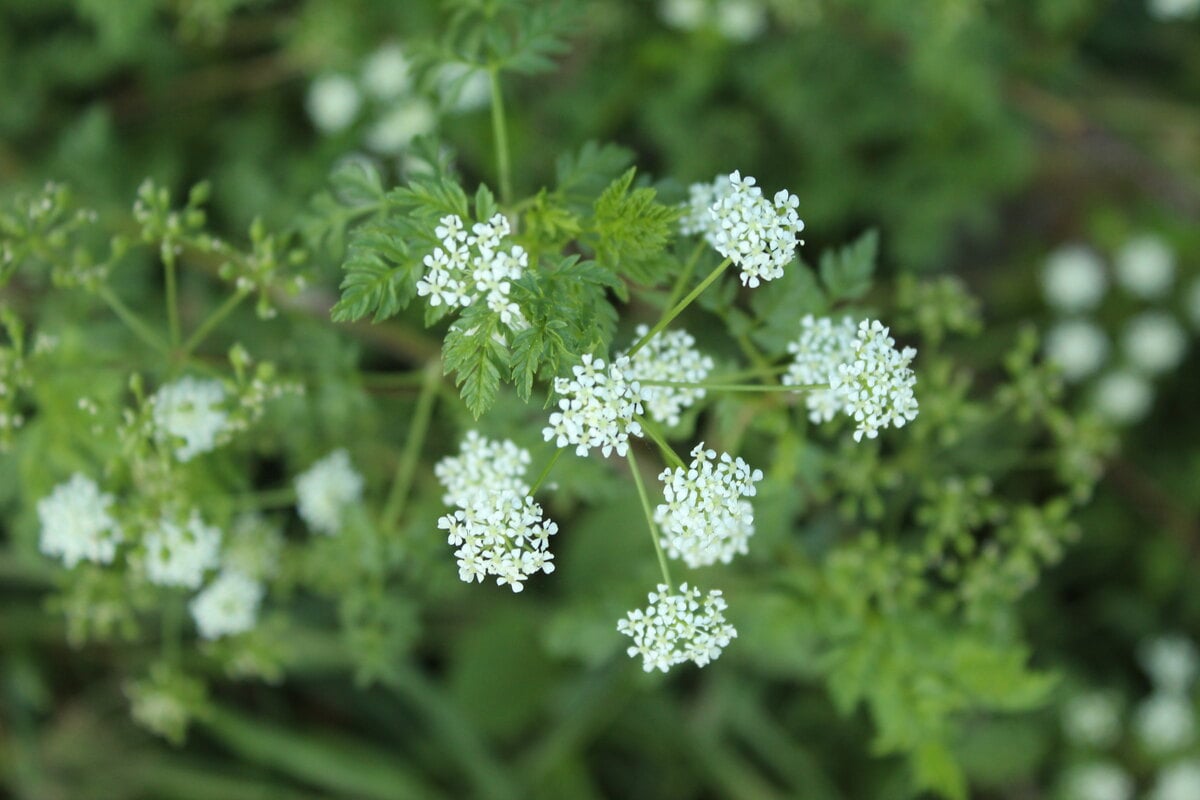
Springtime in the Hawkeye State brings wild temperature swings and tornado threats, but also pesky weeds that can overrun your lawn. Common weeds in Iowa include white clover, crabgrass, and the itch-inducing poison ivy.
This guide will help you spot these weeds early so you can kick them out before they take over. Here’s what we’ll cover:
Broadleaf Weeds
These types of weeds are plants with wide, flat leaves, unlike the narrow blades of grass. Most homeowners in Iowa have had to deal with the following broadleaf weeds at least once:
Black Medic (Medicago lupulina)

Black medic loves to pop up in disturbed soil, so you’ll typically find it in bare patches or areas where you’ve recently dug or raked. It looks harmless with its small, clover-like leaves, but it’s actually a prolific seed producer. Look for tiny, yellow flowers that appear in clusters and turn into dark, coiled seed pods.
Life cycle: Summer annual
Where it thrives: Compacted soil, poor drainage areas, under trees, and near sidewalks
How to identify black medic:
- Small, clover-like leaves
- Tiny, yellow flowers in clusters
- Dark, coiled seed pods
- Low-growing habit
Creeping Charlie (Glechoma hederacea)
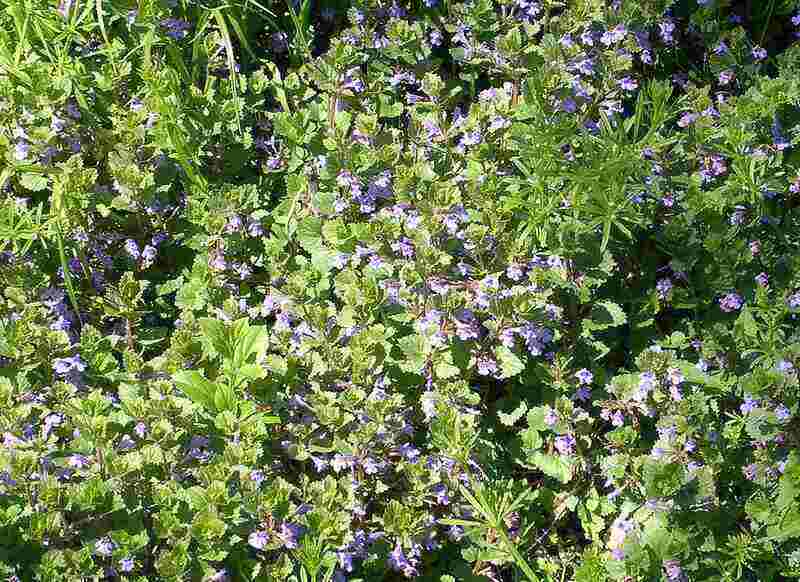
You’ll recognize creeping Charlie (a.k.a ground ivy) by its round, scalloped leaves and square stems. When you crush the leaves, they give off a minty smell, and in the spring, you might spot its tiny lavender flowers popping up.
Life cycle: Perennial
Where it thrives: Shady areas, under trees and shrubs, and in moist, compacted soil
How to identify creeping Charlie:
- Rounded, kidney-shaped leaves with scalloped edges
- Minty smell when leaves are crushed
- Purple flowers in the spring
- Grows low to the ground, forming thick mats
Poison Ivy (Toxicodendron radicans)

Have you ever heard the saying “leaves of three, let it be?” Well, that’s the golden rule for identifying poison ivy. This native Iowa weed has three glossy leaflets on each stem, with the middle one sitting on a longer stalk. You can find it as a low-growing vine, a tall climbing vine on trees, or even as a bushy shrub.
Careful: Don’t touch poison ivy without wearing protective gear. The whole plant contains a sticky oil called urushiol that’ll cause an itchy rash within about 12 to 48 hours of touching your skin. If you have pets, be extra cautious, as they can carry the oil on their fur and spread it to your skin.
The best way to deal with poison ivy is to remove it as soon as you see it. Check out our guide on getting rid of poison ivy for a step-by-step breakdown.
Life cycle: Perennial
Where it thrives: Sunny to shady areas, along fences, or in disturbed soil
How to identify poison ivy:
- Leaves always grow in groups of three
- Produces small, white berries in clusters (late summer)
- Small, greenish-white flowers
White Clover (Trifolium repens)

White clover spreads quickly through stolons and thrives in sunny spots, especially in areas where the grass is thin or stressed. You can easily identify it by its white, round flower heads that look like little balls.
Note: White clover is considered invasive in many parts of the U.S., but isn’t on the Iowa Department of Natural Resources’ Invasive Plants list. This means it doesn’t pose the same threat to your yard as it does elsewhere, so you can actually use it as a beneficial groundcover.
Just keep an eye on its growth: If it starts to take over, read our guide “How to Get Rid of Clover and Not Kill Grass” for effective control tips.
Life cycle: Perennial
Where it thrives: Overly acidic or compacted soil, as well as lawns with low nitrogen levels
How to identify white clover:
- Clover-shaped leaves with three little green leaflets
- Leaves typically have a green or creamy “V” shape on the upper surface
- Up to 12 inches tall
- Great source of nectar for bees and other pollinators
Wild Parsnip (Pastinaca sativa)

Wild parsnip looks a bit like a tall carrot plant with big, feathery leaves. It can grow up to 5 feet tall and produces bright yellow, umbrella-shaped flower heads in early summer. Look for it in sunny areas around your yard, such as bare patches or near garden edges where the grass is weak.
Life cycle: Biennial
Where it thrives: Areas that receive full sun, especially with dry, sandy soil.
How to identify wild parsnip:
- Tall, hollow stem with coarse hairs
- Large, fern-like leaves
- Yellow, umbrella-shaped flower clusters
- Sap that causes painful skin blisters when exposed to sunlight
Wild Violet (Viola sororia)
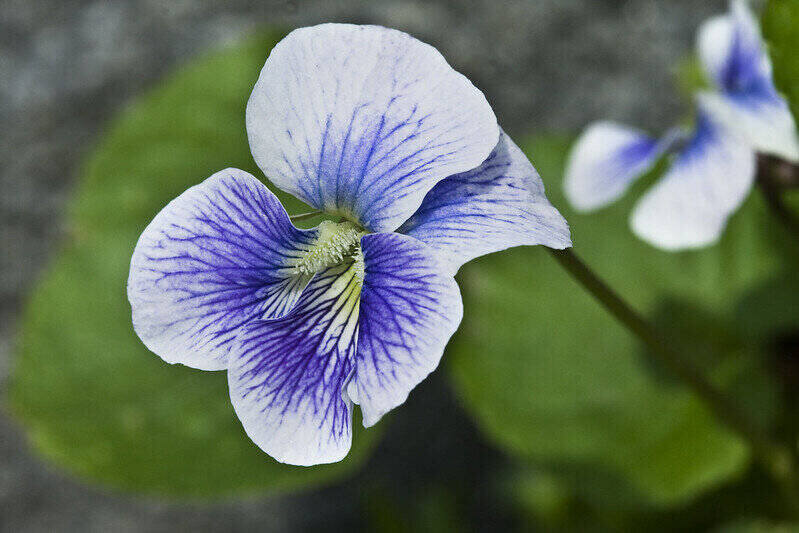
With glossy, heart-shaped leaves and blue to purple flowers, wild violet is another native Iowa perennial that blooms from early spring into late summer. It typically hides under shrubs or trees, where it’s shady and moist.
Life cycle: Perennial
Where it thrives: Shady areas of your yard or moist spots near sprinklers
How to identify wild violet:
- 1 to 2-inch flowers that can be blue, purple, or even white
- Reaches 6 to 10 inches in height
- Its flowers and seeds attract ants, butterflies, and bees
- Often grows in clumps or mats
Grassy Weeds
Unlike broadleaf weeds, grassy weeds are actual grasses that look a lot like your turf. They have long, narrow leaves and an aggressive nature.
Some of the most common grassy weeds you’ll find in Iowa are:
Crabgrass (Digitaria sanguinalis)
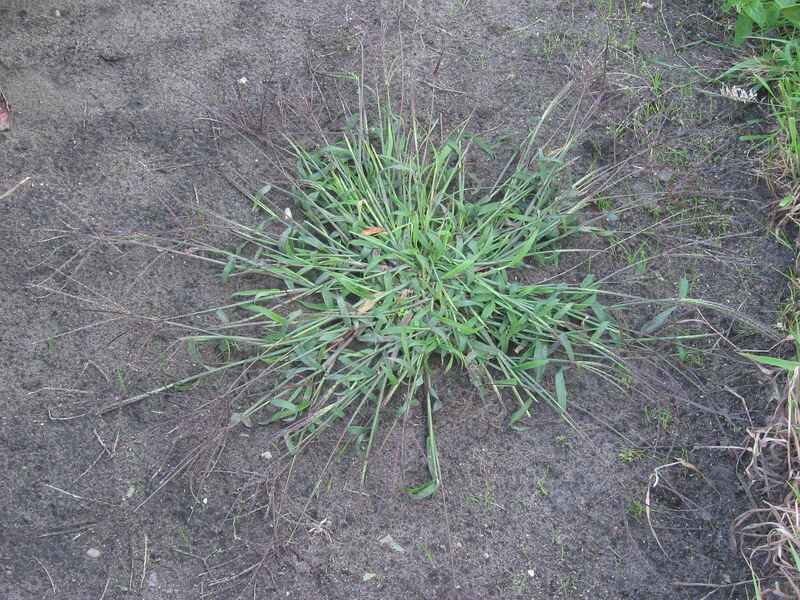
Crabgrass is a real headache for most Iowa homeowners, especially during our scorching summers. It starts as a low-growing patch of grass but quickly spreads out with runners. By midsummer, it’s showing off with tall, spindly stalks and tiny seed heads.
Pro Tip: A crabgrass infestation usually means you’ve been applying too much nitrogen to your lawn. Before putting down any more products, test your soil to find out exactly what it needs. Learn more about soil testing in our article “Why, When, and How to Test the Soil pH of Your Lawn.”
Life cycle: Summer annual
Where it thrives: Thin, bare patches of lawn, compacted soil, and areas with poor drainage
How to identify crabgrass:
- Leaves are wider than regular grass blades and have a slightly hairy texture
- Light green to yellowish-green color
- Can grow up to 3 feet tall
- Seeds form in small, bushy clusters at the end of stems
Here are some other helpful articles on crabgrass:
Yellow Nutsedge (Cyperus esculentus)
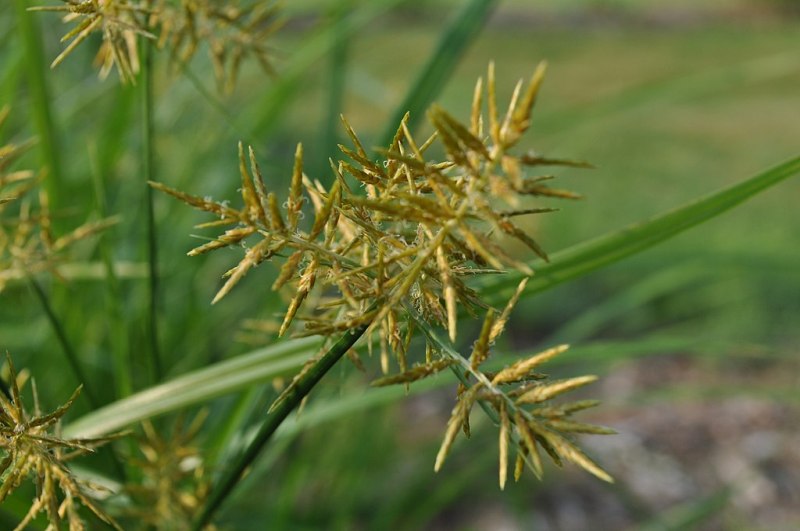
Yellow nutsedge is tough to spot at first glance. It resembles regular grass, with slender, shiny yellow-green leaves that grow in bunches. But if you take a closer look, you’ll notice the leaves are arranged in a triangular pattern around the stem.
You might also spot its yellow-brown flower clusters in mid to late summer. If you pull one up, you’ll see the tubers attached to the roots — those are what allow it to grow back even stronger if you don’t get rid of them properly. Read our article on “How to Control Nutsedge in Your Yard” for tried-and-tested removal methods.
Life cycle: Perennial
Where it thrives: Moist, well-drained soil in areas that get direct sunlight
How to identify yellow nutsedge:
- Triangular-shaped stems
- Between 1 and 3 feet tall
- Grass-like leaves that grow in clumps
- Small, brown nutlets at the base of the plant
Green Foxtail (Setaria viridis)

Green foxtail can grow anywhere from 1 to 4 feet tall and has slender, light green leaves that reach up to a foot long. It grows quickly, especially in warm weather, so it’s most common in southern Iowa lawns. The easiest way to spot green foxtail is by its thick, cylindrical seed heads. They can look green or have a purple tint and are covered in soft bristles that make them look fuzzy —like a fox’s tail.
Pro Tip: Green foxtail indicates that your soil is compacted or your grass isn’t thick. To prevent its spread, aerate and overseed your lawn in early spring. You’ll learn the best ways and times to do it in the following guides:
- Lawn Aeration in Iowa: Everything You Need to Know
- Best Grass Seed for Iowa Lawns
- Lawn Care Schedule for Iowa
Life cycle: Summer annual
Where it thrives: Areas with compacted soil that receive a lot of sunlight
How to identify green foxtail:
- Grows in dense clumps
- Tall, smooth stems, usually hollow in the center, with a few hairs at the base
- Light green, long, and narrow leaves
- Seed heads can attract small birds and other critters
Witchgrass (Panicum capillare)

Witchgrass is kind of similar to a tumbleweed: It starts as a normal-looking grass but turns into a crazy, seed-spreading machine. This summer weed has green to purple-tinged stems covered in fine, stiff hairs and long, pointed leaves.
Life cycle: Summer annual
Where it thrives: Well-drained, disturbed sandy or loamy soils
How to identify witchgrass:
- Tall, thin stems with flat, narrow leaves
- Seeds form in a bushy, hairy head at the top of the weed
- Can look similar to crabgrass, but leaves are flatter and wider
- When it’s dry, the whole plant can break off and roll away to spread its seeds
Noxious Weeds
Noxious weeds are classified by the Iowa Department of Agriculture and Land Stewardship under Chapter 317 of the Iowa Code. These invasive plants spread quickly, outcompete native species, and can cause serious damage to agriculture and natural habitats.
Important: If you find any noxious weeds on your property, it’s your responsibility to control them as soon as possible. If not, you’ll have to deal with fines or even the county stepping in to manage the problem at your expense.
These are some of the most common noxious weeds in Iowa:
Canada Thistle (Cirsium arvense)
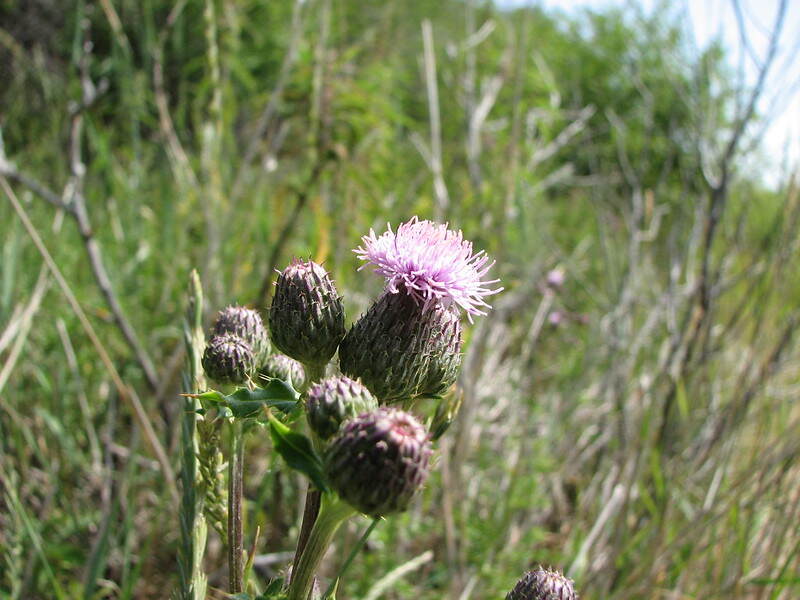
Canada thistle starts as a rosette of leaves close to the ground. As it grows, it shoots up tall, prickly stems with purple flowers. The worst part? It has underground roots that spread like crazy, making it super hard to get rid of.
Lifecycle: Perennial
Weed type: Broadleaf
Where it thrives: Along fences, near garden beds that have been recently tilled, or in patches of thin grass that receive full sun
How to identify canada thistle:
- Can grow up to 3 feet tall
- Small, purple to pink flower heads
- Spiny leaves with jagged edges
- Grows in dense patches or colonies
Bull Thistle (Cirsium vulgare)

Like Canada thistle, bull thistle is covered in sharp spines from head to toe. To tell them apart, look at the leaves. Bull thistle leaves are usually bigger and have a more lobed shape, while Canada thistle leaves are smaller and more deeply divided. Also, bull thistle tends to grow as a single plant, and its stems have spiny wings.
Lifecycle: Biennial
Weed type: Broadleaf
Where it thrives: Disturbed soil, along fence lines, and in open, sunny areas
How to identify bull thistle:
- Large, spiky leaves with white veins
- Tall, prickly stem
- Strong taproot that makes it tough to remove
Quackgrass (Elymus repens)
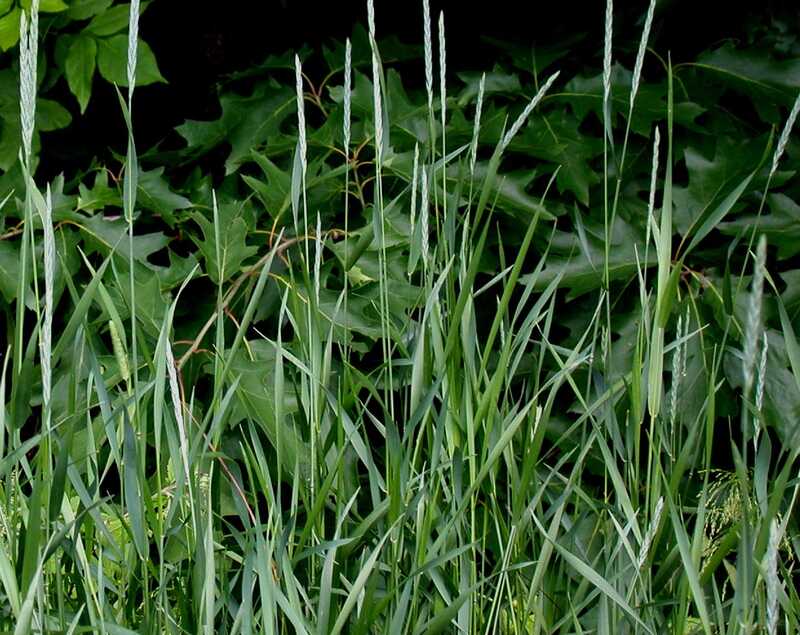
One of the telltale signs of quackgrass is the ear-like appendages at the base of the leaves, which help it grip the soil. You won’t see much above ground, just normal-looking grass blades, but its underground network is what makes it a nightmare. If in doubt, look for its tall seed heads, which have two rows of small flower clusters called spikelets and can measure about 2 to 10 inches long.
Lifecycle: Perennial
Weed type: Grass
Where it thrives: Thin patches, compacted soil, or areas with full sun
How to identify quackgrass:
- Long and narrow, green to whitish leaves
- Sprawling growth habit
- Flower spikes that are 4 to 12 inches long
- Extensive underground roots
Poison Hemlock (Conium maculatum)

Poison hemlock isn’t a plant to mess with. While it has beautiful white flowers and triangular, lacy green leaves, it’s extremely poisonous and can be fatal if ingested. Its thick, hollow stems are what distinguishes it from other similar weeds, thanks to the purple blotches that run along their length.
Lifecycle: Biennial
Weed type: Broadleaf
Where it thrives: Wet areas with disturbed soil
How to identify poison hemlock:
- Grows between 2 to 10 feet tall
- Dark green, triangular leaves
- Clusters of small white flowers that bloom from May to August
- Sturdy stems with distinctive purple spots along the length
Russian Knapweed (Acroptilon repens)

Another aggressive weed, Russian knapweed is a tall cool-season perennial that has hairy, bushy stems with lower leaves that are lobed and jagged. From late spring to early fall, it blooms small pink to lavender flowers that attract bees and other pollinators.
Lifecycle: Perennial
Weed type: Broadleaf
Where it thrives: Next to garden beds or in patches where the grass is sparse and compacted
How to identify Russian knapweed:
- Gray-green, spiny leaves
- Purple, button-like flower heads
- Tall, branching stems that are also covered in spines
- Grows in clumps or patches
FAQ About Common Iowa Lawn Weeds
Are there resources in Iowa for identifying weeds?
Absolutely. A great place to start is the Iowa State University Extension website. They offer a wealth of information on common Iowa weeds, including pictures, descriptions, and a handy Weed Identification Field Guide. You can also check out local garden centers or nurseries for expert advice.
What should I do if I have a noxious weed in my yard?
If you spot a noxious weed, take action right away. Contact your local county extension office for specific guidance. They can help you identify the weed and recommend control methods. You may also need to report the infestation to your local authorities.
Can I replace invasive weeds with native Iowa plants?
Yes. Actually, native plants are well-adapted to Iowa’s climate and soil, so they’ll help you crowd out invasive weeds and promote a healthier ecosystem in your yard. For some recommendations, check out our Iowa native plant guide.
When to Call a Professional
Figuring out what’s invading your Iowa lawn can be a real puzzle, especially with tricky weeds like poison hemlock or the super stubborn quackgrass. Sometimes, all you need is an expert’s eye. Reach out to a lawn care pro in your neighborhood through LawnStarter —we have reliable professionals across Iowa, ready to tackle the toughest weeds without you lifting a finger.
Main Image Credit: Poison hemlock / Nicolas Ramirez / Wikimedia Commons / CC BY-SA 4.0



